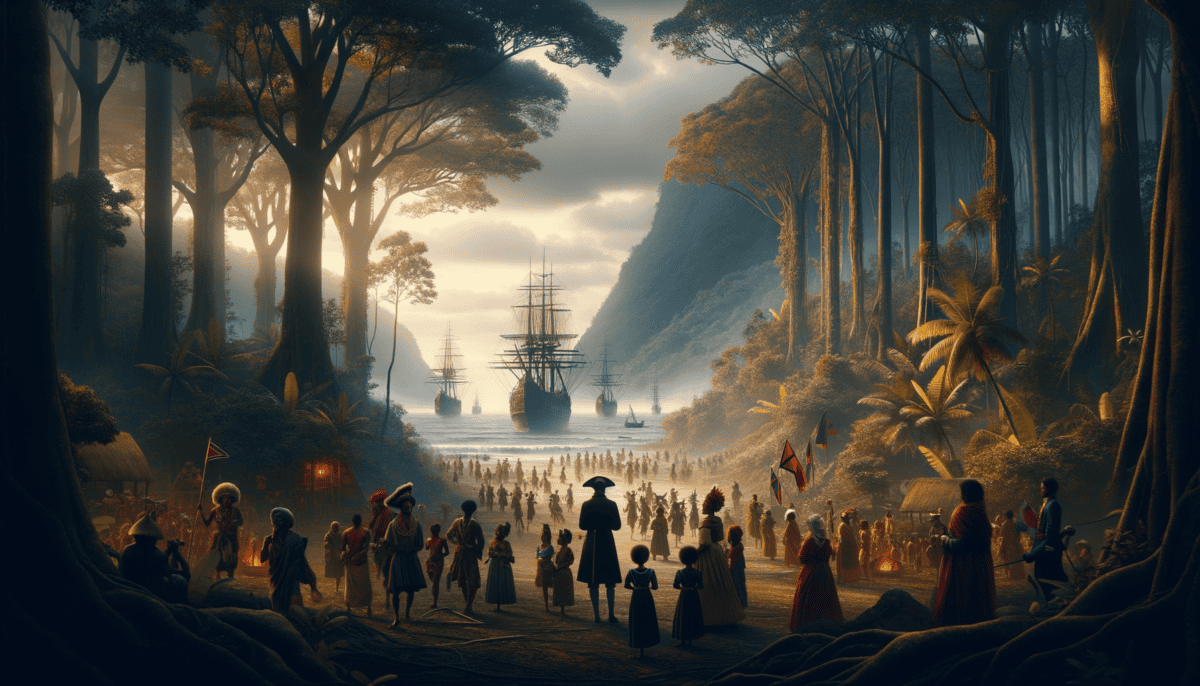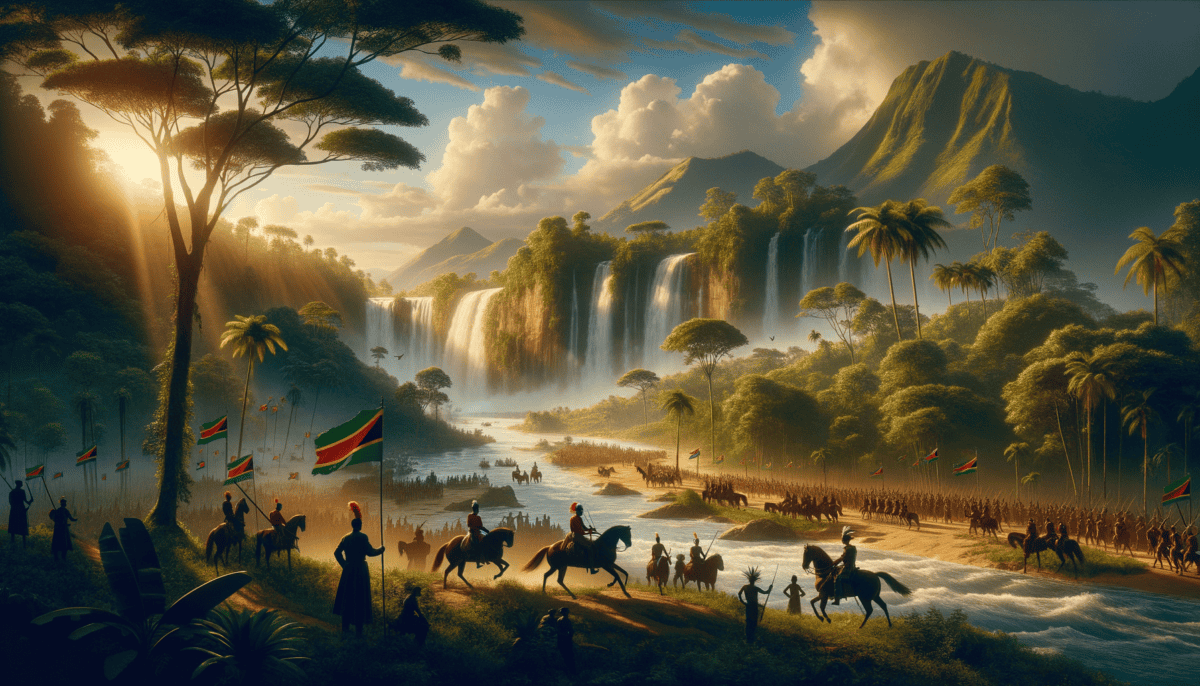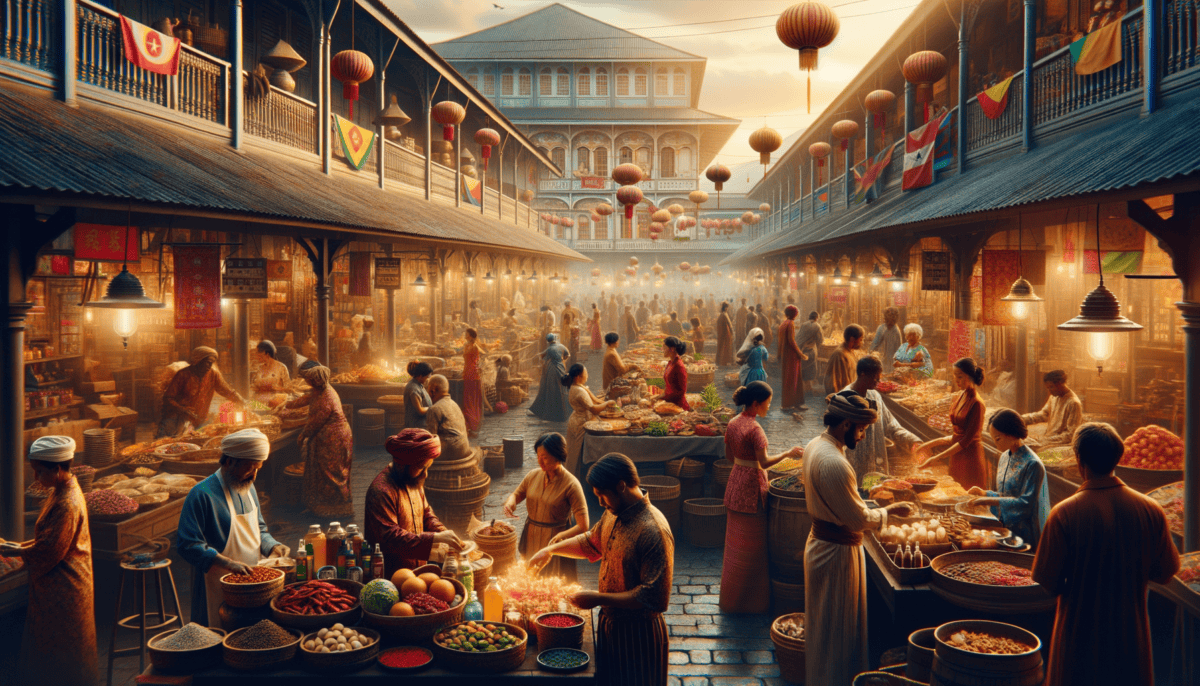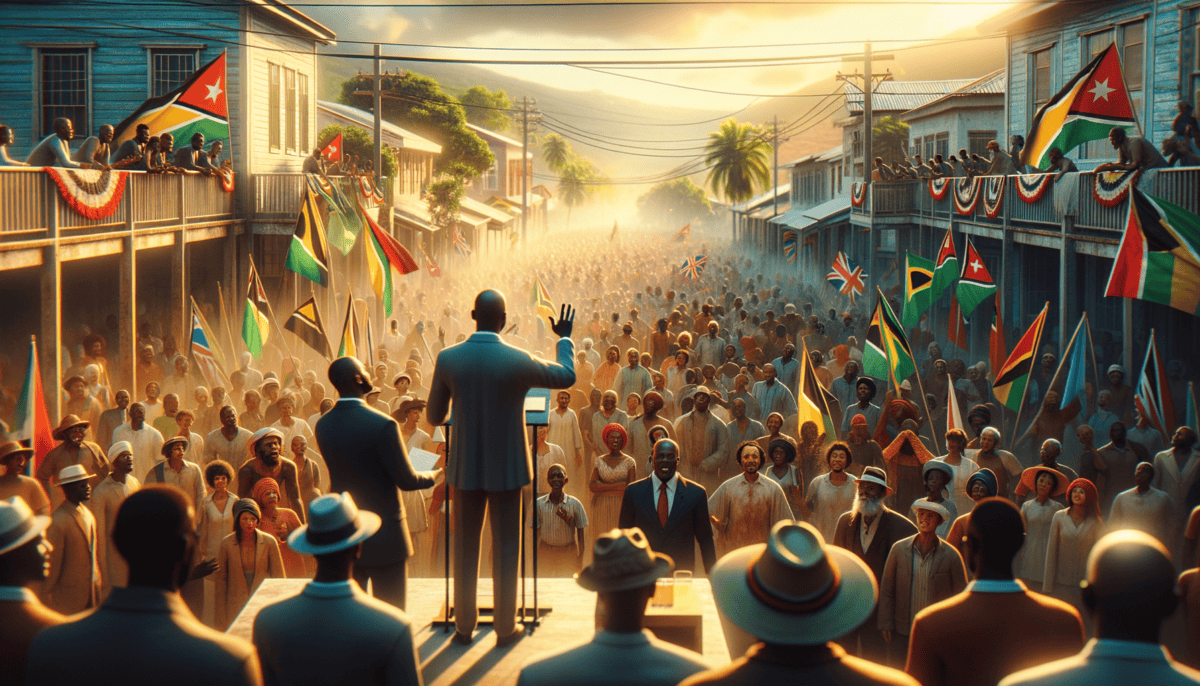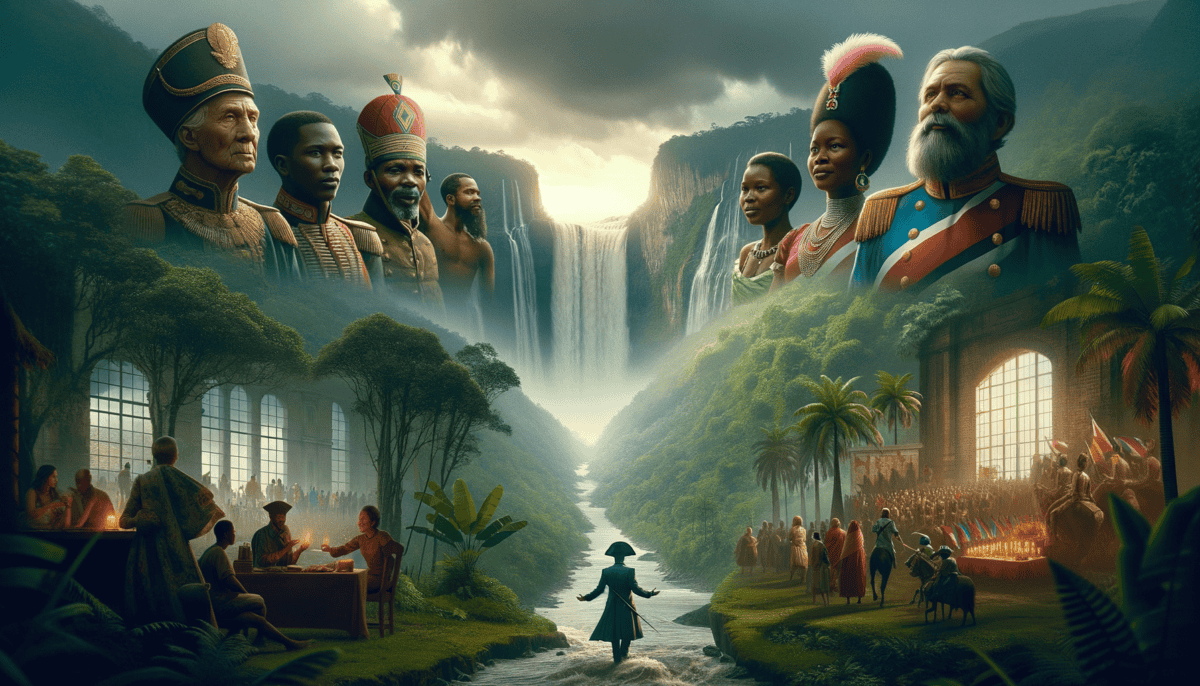Land of Many Waters
Deep in South America, where the mighty rivers meet the sea, lies a special place called Guyana. Long ago, before big ships and tall buildings, the Arawak and Carib people made this beautiful land their home.
"Look at how the water sparkles like diamonds!" young Tala exclaimed, pointing to the rushing Essequibo River. Her grandfather, Chief Akaimi, smiled warmly as they sat on the riverbank.
"Our people have lived by these waters since the time of the first sunrise," he said, his eyes twinkling. "That's why we call this land 'Guiana' – it means 'Land of Many Waters' in our language."
The dense rainforest stretched as far as anyone could see. Colorful macaws soared overhead, their bright feathers painting the sky in red and blue. Below, tapirs and jaguars moved quietly through the thick green forest.
"Tell me about our people, grandfather," Tala asked, weaving a basket from palm leaves just as her mother had taught her.
Chief Akaimi began sharing the stories passed down through generations:
Important Things the Native People Did:
• Built homes called benabs using wood and leaves
• Fished in the rivers using special nets
• Grew cassava and other foods in the forest
• Made beautiful pottery with special designs
• Used plants as medicine to heal sick people
The Arawak people were peaceful farmers who lived in villages near the rivers. They paddled long canoes through the water highways of their world. The Caribs were brave warriors who protected their territory fiercely.
Little Tala watched as her people worked together. Some wove hammocks from cotton they had grown themselves. Others shaped clay into pots decorated with swirling patterns that told stories of their ancestors.
The evening sun painted the sky orange as smoke rose from cooking fires. Women prepared pepper pot, a special stew made with cassava juice and meat. Children played games with seeds and stones, while elders shared wisdom around the fire.
"But grandfather," Tala asked, "will our way of life stay the same forever?"
Chief Akaimi looked toward the horizon, where the great ocean lay beyond the forest. "Change comes like the tide, little one. But remember – our stories, our knowledge, and our love for this land will live on as long as people like you keep them in your heart."
As night fell, the sounds of the rainforest created a gentle symphony – frogs croaking, night birds calling, and leaves rustling in the warm breeze. Tala snuggled into her hammock, dreaming of the beautiful land she called home.
Strange rumors had begun reaching their village. Tales of huge boats on the horizon and pale-skinned people speaking unknown languages. But that was a story for another day…
Winds of Change
The morning sun had barely risen when Tala heard excited voices from the river. “Strange boats! Strange boats!” children shouted as they ran through the village.
“Come quickly, Tala!” her friend Kai called. Together they raced to the riverbank where a crowd had gathered.
Chief Akaimi stood at the water’s edge, watching as huge wooden ships with white sails approached. They were bigger than anything the villagers had ever seen.
“Who are they, grandfather?” Tala whispered, holding tight to his hand.
“They are called Spanish explorers,” he answered quietly. “And they will bring many changes to our land.”
• Spanish sailors looking for gold
• Dutch traders wanting to build farms
• English and French people seeking new homes
At first, some things stayed the same. The native people continued fishing and farming as they always had. But soon more ships arrived, bringing the Dutch who wanted to build big farms called plantations.
“Look how they change the land,” Tala said sadly, watching as trees were cut down to make space for sugarcane fields.
The Dutch built strong walls called dikes to keep the sea water out. They dug long ditches to drain the wet land. Soon they built their first settlement, called Stabroek (which would later become Georgetown).
“We must learn to live with these changes,” Chief Akaimi told his people. “But we will never forget our own ways.”
Some native people traded with the newcomers, exchanging food and handicrafts for metal tools and cloth. Others moved deeper into the forest to keep their traditional way of life.
Little Tala watched as strange new buildings rose along the coast. The Dutch built forts to protect their settlements. They created new laws and brought their own leaders.
Years passed, and more changes came. The Spanish tried to take control from the Dutch. The French and English joined in the fight. Each group wanted Guyana’s rich land for themselves.
Through it all, the native peoples watched and waited. They shared their knowledge of the land when they could, and protected their traditions as best they could.
One evening, as Tala – now grown older – sat with her own children by the river, she remembered her grandfather’s words about change coming like the tide. She looked at the mix of native villages and European settlements along the shore and knew bigger changes were still to come.
Dark clouds were gathering on the horizon. Soon, ships of a different kind would arrive, bringing people in chains to work on the plantations. But that was a story that would bring both great sadness and great courage…
Legacy of Resistance
The sun rose blood-red over the sugar plantations of Berbice. Cuffy stood in the shadows of the cane fields, his heart heavy as he watched his people working under the cruel overseer’s whip.
“We cannot live like this anymore,” Cuffy whispered to his friend Akara. “Our children deserve better than chains.”
The plantation system had brought terrible changes to Guyana. Ships arrived regularly at the coast, carrying captured people from Africa to work on the sugar and cotton fields.
“Each morning I count the stars still visible in the sky,” said Mama Akuba, the village storyteller. “They remind me of the stories my grandmother told me in Africa – stories of freedom.”
Life on the plantations was very hard. People worked from sunrise to sunset in the hot fields. But even in these dark times, they found ways to keep their culture alive.
• Share stories from Africa
• Sing songs in their native languages
• Practice traditional dances
• Keep their customs alive through secret meetings
“Tell us about home, Mama Akuba,” the children would beg during rare moments of rest.
She would smile and say, “Home is where your heart stays strong, little ones. And our hearts remember Africa.”
One night, Cuffy called a secret meeting. “Tomorrow,” he announced, “we fight for our freedom!”
The rebellion started at dawn. The enslaved people took control of several plantations. Cuffy became their leader, showing great skill in organizing and inspiring others.
For almost a year, the rebels held control of Berbice. Cuffy proved to be a wise leader, trying to create fair rules for everyone. He even tried to make peace talks with the Dutch.
Though the rebellion was eventually defeated, it showed the strength and courage of the human spirit. The story of Cuffy’s rebellion inspired many more fights for freedom.
Years later, when slavery finally ended, the people celebrated with drums and songs that had been kept alive through all the hard times.
But freedom brought new challenges. The plantation owners still wanted cheap workers. Soon, ships would arrive carrying people from India, China, and Portugal. These new arrivals would add their own beautiful colors to Guyana’s growing rainbow of cultures…
A Rainbow of Cultures
The morning mist rolled across Georgetown’s harbor as a large ship appeared on the horizon. The year was 1838, and Guyana was about to welcome new faces from far away.
Young Arun stood on the deck, clutching his mother’s sari. “Mama, what will our new home be like?”
His mother smiled gently. “It will be different, beta. But we will make it beautiful with our songs and stories.”
“Look at those strange trees,” whispered Ming Li, a girl who had arrived from China the month before. “They dance differently from the bamboo back home.”
The plantation owners had invited workers from many lands to come to Guyana. They came from:
• China with their ancient traditions
• Portugal with their lively music
• Africa, bringing more rich culture
At first, everyone stayed in their own groups. But slowly, wonderful things started to happen.
“Would you like to try some curry?” Arun’s mother asked Ming Li one day.
“Yes! And you must taste my dumplings,” Ming Li replied with a bright smile.
In the villages, new sounds filled the air. The beat of African drums mixed with Indian tablas. Chinese erhu strings danced with Portuguese guitars.
“Listen,” said old Thomas, who remembered the days of slavery. “Our different songs are making something new and beautiful together.”
The children were the first to break down walls. They played together, sharing games from their homelands. Soon, they were speaking bits of each other’s languages.
“My grandmother says that when we share food and stories, we become family,” said Arun to his new friends.
Special celebrations began to bring everyone together. During Diwali, the Indian festival of lights, everyone helped light tiny clay lamps. At Chinese New Year, the whole village celebrated with red decorations and special treats.
Years passed, and something magical happened. The children grew up and married across cultural lines. Their babies were born with the songs of many lands in their hearts.
Each group added their own special gifts to Guyana:
The Indians brought their rich spices and festivals. The Chinese shared their careful farming methods and healing arts. The Portuguese added new music and trading skills. The Africans continued sharing their strong traditions and wisdom.
As the sun set over Georgetown, the sounds of many languages filled the evening air. Children played in the streets, their faces showing the beautiful mix of cultures that was becoming uniquely Guyanese.
A cool breeze carried the smell of curry, chow mein, and pepperpot through the streets. In homes across the land, families gathered to share meals that told the story of their remarkable journey together.
Dreams of Freedom
The year was 1950, and change was stirring in Guyana like a gentle breeze that grows into a mighty wind. ️
“We must be free to choose our own path,” declared Dr. Cheddi Jagan, speaking to a crowd gathered in Georgetown’s square. His voice carried hope and dreams of independence.
Little Maya listened from her father’s shoulders. “Papa, what does independence mean?”
“It means writing our own story, sweetheart,” her father explained. “Making our own choices for our future.”
All across Guyana, people began meeting in small groups. They talked about big dreams:
• Making their own laws
• Choosing their own leaders
• Building better schools
Forbes Burnham, another important leader, spoke at the docks where workers gathered. “We are like a family with many different faces, but one heart beating for freedom!”
In the marketplace, Mrs. Chen watched her children play with their friends – Indian, African, Portuguese, and mixed families all together.
Young Peter ran home excited one day. “Mama! We learned about voting in school today. Teacher says soon we’ll help choose who leads our country!”
“Times are changing,” his mother smiled. “Your grandfather couldn’t vote, but you will help shape Guyana’s future.”
In 1953, something big happened. For the first time, all adults could vote for their leaders. People lined up for hours, proud to make their voices heard. ✨
Not everyone agreed on how things should change. Sometimes there were arguments and worried faces. But most people kept their eyes on the dream of independence.
“Remember,” Grandmother told Maya, “a family can disagree but still love each other. Our different ideas can make us stronger.”
Leaders traveled to London to talk with British officials. They carried the hopes of all Guyanese people in their hearts.
As the sun set over the Demerara River, Maya sat with her friends on the seawall. They were children of all backgrounds, dreaming together about their country’s future.
The evening breeze carried their laughter across the water, mixing with the sounds of steel drums and cricket games. Change was coming to Guyana, and its people were ready to embrace their destiny.
A Dream Realized
The morning of May 26, 1966, dawned bright and beautiful in Georgetown. The air buzzed with excitement as people filled the streets.
“Today’s the day!” shouted Maya, now a teenager, as she helped her mother hang decorations. “We’re becoming independent!”
“After all these years of dreaming,” her mother whispered, wiping happy tears, “Guyana will finally be free.”
The new flag sparkled in the moonlight. Its colors told Guyana’s story:
• Gold for mineral wealth
• Red for the people’s spirit
• Black for strength
• White for rivers
Peter, now grown up, stood with his children. “Remember this day,” he said. “We’re writing our own story now.” ✍️
The first years weren’t easy. Building a new nation was like learning to walk – there were stumbles along the way. But Guyanese people worked together to face each challenge.
Schools opened their doors to all children. Farmers grew more food. New businesses started. The country was growing stronger every day.
“Look how far we’ve come,” Mrs. Chen told her grandchildren. “When I was young, we couldn’t even vote. Now we run our own country!”
By the 1980s, Guyana had changed a lot. Modern buildings rose in Georgetown. Oil was discovered offshore. The future looked bright! ✨
Maya, now a grandmother herself, sits with her grandchildren on the same seawall where she once dreamed of freedom.
“Tell us the story again,” they beg. “About how Guyana became free!”
She smiles, remembering that special day in 1966. “It’s a story of many peoples coming together,” she begins. “Of dreams, hard work, and hope…”
The sun sets over modern Guyana, its golden light touching skyscrapers and rainforests alike. The Demerara River still flows strong, carrying the dreams of new generations.


